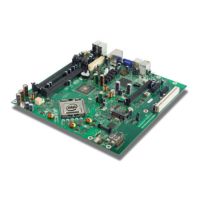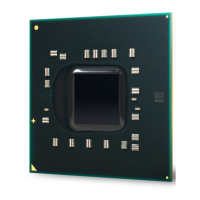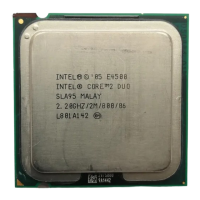Intel® Thermal/Mechanical Reference Design Information
Thermal and Mechanical Design Guidelines 47
While the fan hub thermistor helps optimize acoustics at high processor workloads by
adapting the maximum fan speed to support the processor thermal profile, additional
acoustic improvements can be achieved at lower processor workload by using the
T
CONTROL
specifications described in Section 2.2.3. Intel recommendation is to use the
Fan Specification for 4 Wire PWM Controlled Fans to implement fan speed control
capability based on the digital thermal sensor. Refer to Chapter
6 for further details.
5.2.3 Altitude
The reference heatsink solutions were evaluated at sea level. However, many
companies design products that must function reliably at high altitude, typically
1,500 m [5,000 ft] or more. Air-cooled temperature calculations and measurements at
sea level must be adjusted to take into account altitude effects like variation in air
density and overall heat capacity. This often leads to some degradation in thermal
solution performance compared to what is obtained at sea level, with lower fan
performance and higher surface temperatures. The system designer needs to account
for altitude effects in the overall system thermal design to make sure that the T
C
requirement for the processor is met at the targeted altitude.
5.2.4 Reference Heatsink Thermal Validation
The Intel reference heatsink was validated within the specific boundary conditions
based on the methodology described Section
5.3 , and using a thermal test vehicle.
Testing is done on bench top test boards at ambient lab temperature. In particular, for
the reference heatsink, the Plexiglas* barrier is installed 81.28 mm [3.2 in] above the
motherboard (refer to Section
3.3).
The test results, for a number of samples, are reported in terms of a worst-case mean
+ 3 value for thermal characterization parameter using real processors (based on the
thermal test vehicle correction factors).
Note: The above 81.28 mm obstruction height that is used for testing complies with the
recommended obstruction height of 88.9 mm for the ATX form factor. However, it
would conflict with systems in strict compliance with the ATX specification which
allows an obstruction as low as 76.2 mm above the motherboard surface in Area A.

